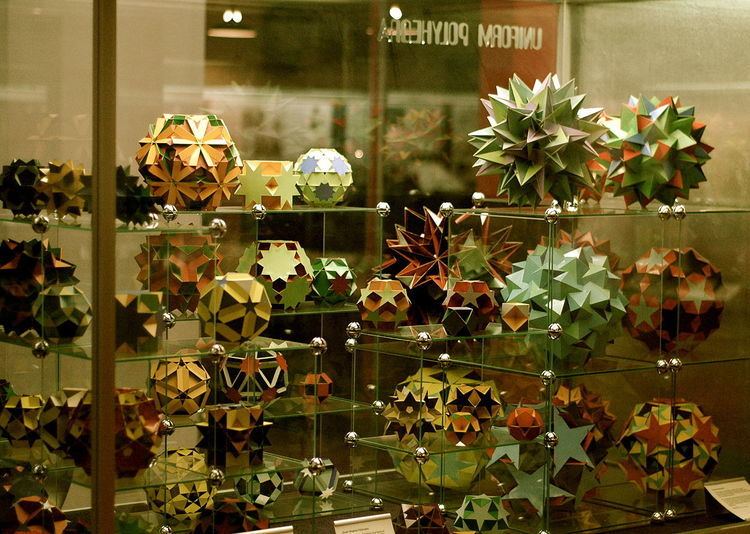 | ||
In geometry, a uniform star polyhedron is a self-intersecting uniform polyhedron. They are also sometimes called nonconvex polyhedra to imply self-intersecting. Each polyhedron can contain either star polygon faces, star polygon vertex figures or both.
Contents
- Dihedral symmetry
- Tetrahedral symmetry
- Octahedral symmetry
- Icosahedral symmetry
- Degenerate cases
- Skillings figure
- References
The complete set of 57 nonprismatic uniform star polyhedra includes the 4 regular ones, called the Kepler–Poinsot polyhedra, 5 quasiregular ones, and 48 semiregular ones.
There are also two infinite sets of uniform star prisms and uniform star antiprisms.
Just as (nondegenerate) star polygons (which have Polygon density greater than 1) correspond to circular polygons with overlapping tiles, star polyhedra that do not pass through the center have polytope density greater than 1, and correspond to spherical polyhedra with overlapping tiles; there are 48 nonprismatic such uniform star polyhedra. The remaining 9 nonprismatic uniform star polyhedra, those that pass through the center, are the hemipolyhedra, and do not correspond to spherical polyhedra, as the center cannot be projected uniquely onto the sphere.
The nonconvex forms are constructed from Schwarz triangles.
All the uniform polyhedra are listed below by their symmetry groups and subgrouped by their vertex arrangements.
Regular polyhedra are labeled by their Schläfli symbol. Other nonregular uniform polyhedra are listed with their vertex configuration or their Uniform polyhedron index U(1-80).
Note: For nonconvex forms below an additional descriptor Nonuniform is used when the convex hull vertex arrangement has same topology as one of these, but has nonregular faces. For example an nonuniform cantellated form may have rectangles created in place of the edges rather than squares.
Dihedral symmetry
See Prismatic uniform polyhedron.
Tetrahedral symmetry
There is one nonconvex form, the tetrahemihexahedron which has tetrahedral symmetry (with fundamental domain Möbius triangle (3 3 2)).
There are two Schwarz triangles that generate unique nonconvex uniform polyhedra: one right triangle (3/2 3 2), and one general triangle (3/2 3 3). The general triangle (3/2 3 3) generates the octahemioctahedron which is given further on with its full octahedral symmetry.
Octahedral symmetry
There are 8 convex forms, and 10 nonconvex forms with octahedral symmetry (with fundamental domain Möbius triangle (4 3 2)).
There are four Schwarz triangles that generate nonconvex forms, two right triangles (3/2 4 2), and (4/3 3 2), and two general triangles: (4/3 4 3), (3/2 4 4).
Icosahedral symmetry
There are 8 convex forms and 46 nonconvex forms with icosahedral symmetry (with fundamental domain Möbius triangle (5 3 2)). (or 47 nonconvex forms if Skilling's figure is included). Some of the nonconvex snub forms have reflective vertex symmetry.
Degenerate cases
Coxeter identified a number of degenerate star polyhedra by the Wythoff construction method, which contain overlapping edges or vertices. These degenerate forms include:
Skilling's figure
One further nonconvex degenerate polyhedron is the Great disnub dirhombidodecahedron, also known as Skilling's figure, which is vertex-uniform, but has pairs of edges which coincide in space such that four faces meet at some edges. It is counted as a degenerate uniform polyhedron rather than a uniform polyhedron because of its double edges. It has Ih symmetry.
